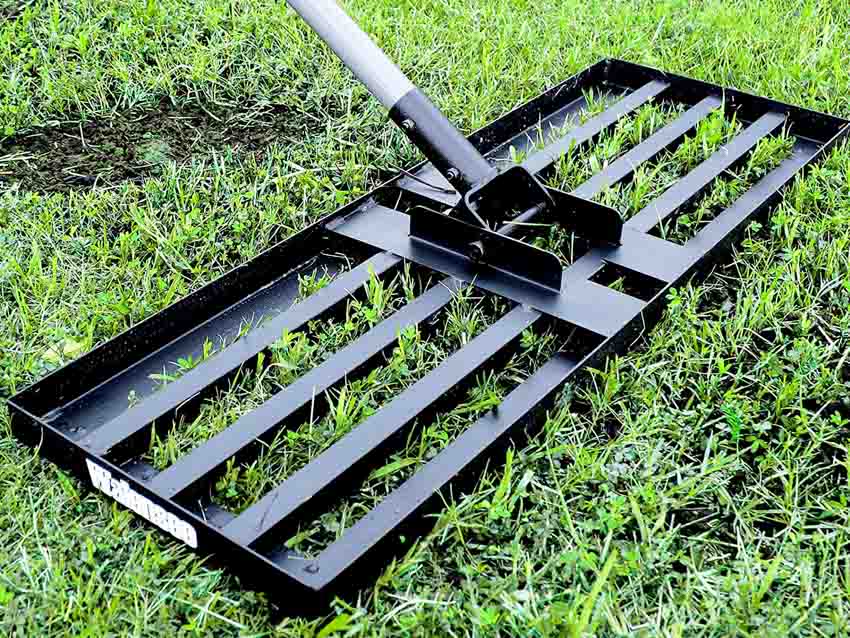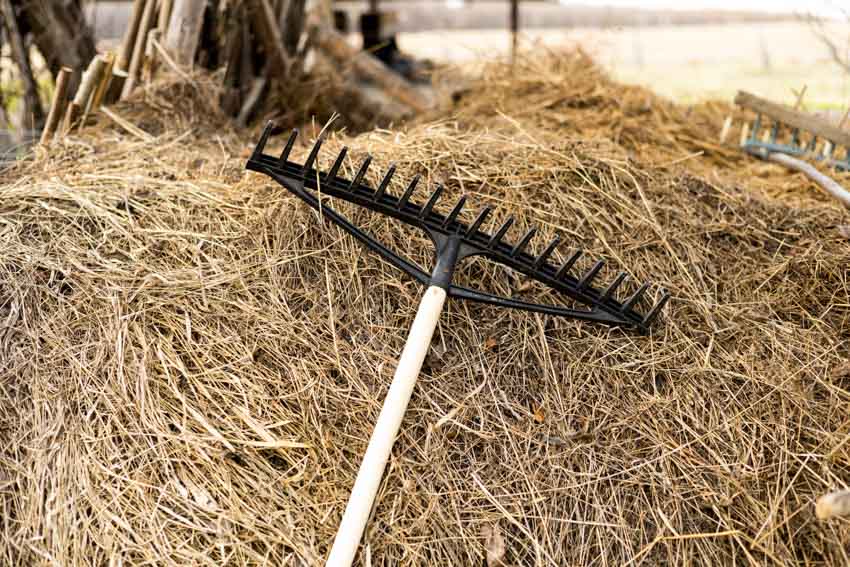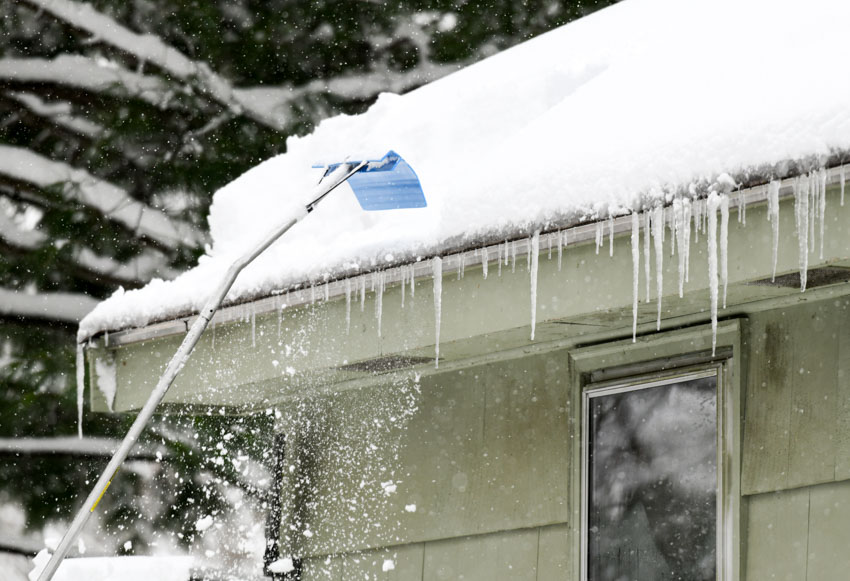17 Types Of Rakes (Uses & Pictures)

You probably think of a rake as the tool to get the leaves out of your yard. While this is an excellent use for the tool, the right types of rakes can actually help make a lot of your outdoor chores a lot easier. As long as you have the right style, you can make short work of your landscaping and a few other jobs you may not have thought of. Below, we share the different types of rakes, including their uses, design pictures, features, and how they can best help with tasks around your home’s yard.
Leaf Rake
Leaf rakes, as the name suggests, are used for leaves fallen from trees. These are essential if you have a lot of trees in your yard that start to shed as the seasons change. Aside from aesthetics, removing leaves from your lawn can help avoid slippery surfaces or blocking your lawn from accessing its needs like sunlight.
A standard leaf rake is long enough to use while standing with a distinct fan shape. Wider options are available for larger areas, but the wider this design is, the more strain you’re likely to feel on your back. You can usually find these tools in widths up to 30 inches.
To make the process easier, you can opt for a leaf scoop rake, which will help grab the leaves and push them around. These designs are often modeled as a handheld design.
Garden Rake
A garden rake is another type common in most homes. These have a long handle and a wide head. Instead of fanning out like a leaf rake, though, garden rakes have a straight head perpendicular to the handle. The handle is usually made of wood or metal, and the tines are often made of metal, so they’re sturdy.
These are a bit of a multi-purpose tool compared to some others. They’re great whether you need to rake up a few leaves, move the soil in your garden around, aerate the soil, or even clean up something tougher like gravel. That’s why the metal tines are so handy and what makes this type so popular.
Bow Rake

Bow rakes are another name for garden types. This means they’re great for a variety of jobs in your yard, and they’re a common, sturdy choice.
Landscape Rake

A landscape rake isn’t the type a homeowner usually keeps in their shed. Instead, you’re more likely to find this alongside a professional landscaper’s supplies. They’re reliable and versatile but often more than the average homeowner needs.
These can have a variety of shapes and designs, but their metal heads are incredibly wide compared to the average one you’d have in most types of sheds or garages.
The purpose of this is to allow the user to cover a lot of ground quickly. This is useful in making short work on commercial landscaping projects. The metal design of the tool helps this, too. It holds up over time, even if used frequently on hours-long, large projects.
Thatch Rake
Thatch is a layer of plant debris on your lawn. You’ll notice it building up on your lawn after a while, and it isn’t always bad. If it gets too thick, however, it can start to choke your lawn and deprive it of the nutrients it needs to survive. When this happens, you’ll need to dethatch your lawn.
This is where a thatch rake comes in handy. You might also hear this referred to as a dethatching or a scarifying rake. These usually have a double-sided head.
One side is meant to help you tear up the layer of thatch on your lawn while the other pulls it away from the surface. These would be a little harsh on your lawn for leaves, so they’re best left to dethatching.
Gravel Rake

If you try to sweep up pebbles, rocks, or gravel with a leaf rake, you’ll likely see more damage to your tool than effectiveness in your task. A gravel rake is made to handle this level of work.
To do so, they’re typically made up of either aluminum or steel and have a perpendicular metal head about 18 to 28 inches wide. Yet, they’re still lightweight enough to make them easy to handle.
The tines are metal, too, meaning they can hold up to moving rocks around quite well. You can use it to push different types of gravel or pebbles around or pull them towards you, similar to how you’d rake leaves. The handle is typically made of the same metal or fiberglass with a cushioned grip to make it more comfortable to hold.
Hand Rake
A hand rake is much smaller than the average type you’d use for leaves. They get their name because they’re a tool you can hold in your hand. Usually, this includes a handle made out of metal, wood, or plastic and a metal head, usually made up of a few strong tines.
Looking for a handle with an ergonomic design will help make the use of the tool more comfortable. These are the best choice when you need precision over speed and area since you have more control with the shorter handle and compact design.
For instance, if you’re working in your garden amongst your flowerbeds, they can help you complete the job without knocking into your plants and damaging them in the process. Aside from removing debris, these are great when you want to turn your garden or till the soil as well.
Power Rake

Power rakes have an advantage in that they don’t require as much work from you as a mechanical one. On the contrary, these look more like lawnmowers and all you have to do is power up the engine and push them along.
Sometimes, they are limited by a corded design, but this does offer a consistent power source. Otherwise, they’ll need gasoline as fuel. These tools are often designed to help with more labor-intensive projects like removing thatch rather than ridding your lawn of leaves as they fall.
If you want to make the cleanup from this job even easier, some power rakes feature a bag to catch the debris it tears up. Models without it will spit out the debris, usually dropping it behind them.
Carpet Rake

A carpet rake is made to help you indoors rather than outside. This type is intended for use on your carpets for a few different reasons. These often look like wide brooms with a rake’s handle rather than the tines we usually associate with the design. The average width of these rakes for home use is 12 inches, but you can find models up to 18 inches across.
Carpet rakes are often used prior to cleaning carpets to agitate them. However, they’re also useful in thoroughly applying treatments such as anti-static and fabric protector treatments. This makes it a handy tool both before and after deep cleaning your carpet to help it look like new.
Hay Rakes
A hay rake is another large option you don’t see in the average suburban home. These tools are more common on small farms. They’ll find more use there since they’re for gathering hay or, conversely, spreading it out. These types feature a wide head and strong metal tines and, like landscape rakes, are meant to cover a lot of ground at once.
These operate in one of two ways. You can opt for the old-fashioned way and use a hay rake that you pull along manually. For a faster, more efficient option, there are models you can attach to the back of a vehicle like a tractor to pull them along. This would definitely help you conserve energy, too.
Roof Rake
Contrary to most types, you shouldn’t use your roof rake on the ground. These models are meant for use on certain roof types. Because of this, you’ll notice that these are some of the most lightweight rakes around, and they’re often made of plastic.
These are rather versatile tools to keep your roof clean. In the fall, they’re great for sweeping leaves and other debris away with less effort. Once the weather starts to turn even colder, you can use them to sweep snow off your roof.
These types often feature extendable handles. This way, you can use them without necessarily breaking out a ladder to climb up on the roof yourself.
Berry Rake

When the season is right, there are few things better than picking some ripe berries. However, you don’t have to struggle for each berry. A berry rake can help a lot. These look like small buckets with a handle.
Rather than having a rounded shape, though, these tools have one flat side with an edge made up of metal tongs. Berry rakes are used to scoop the berries from trees. The tines help pull them from the branch, and the bucket catches them as they fall.
If you have a berry tree, these models can help you save time and enjoy your fresh snacks more conveniently. Plus, it keeps you from picking berries up off the ground as they fall.
Root Rake
Root rakes are usually rather large and attached to a vehicle rather than a handle for manual use. To add to their strength, these are made of strong metal to stand up to their jobs.
Root rakes are used for two primary purposes. Of course, you can use them to move large debris such as branches or even small trees. The primary advantage of these types, though, is that they’re strong enough to tear roots and tree stumps from the ground in no time at all.
Pond Rake

Pond rakes are also known as lake rakes. These are made to help you tackle some of the debris you might see in these bodies of water. After all, not many people want to jump in when they look down and see a thick layer of algae.
These styles aren’t scraped along the ground or base of the body of water, either. To remove this debris, you’ll want to move the tines along the surface of the pond or lake, similar to how you might skim a pool for debris. These tools often have a wide head but a lightweight body, so it’s still easy to hold them balanced while you skim the surface of your pond or lake.
Lawn-Leveling Rake

An uneven lawn doesn’t work for everyone, and a lawn-leveling rake can help before you jump in to call a professional. These types have a flat head that fully comes into contact with the ground you move over it with.
The tines it sports are typically made of metal and can either be curved or straight. Straight tines are more common, but curved tines are more versatile. Use this leveler across your sod grass to help move the ground into a more level position with relative ease, thanks to the blade.
Concrete Rake
A concrete rake isn’t made of concrete but actually relies on a metal head. Their name comes from the fact that they’re used when laying concrete. They’re used both to push and smooth concrete as well as scoop up concrete and move it as needed.
For this purpose, concrete rakes are designed slightly differently from most types. The first thing you’ll notice is that these designs don’t have tines. In its place, they boast a head with a curved design.
The straight edge is used to flatten the concrete into place, while the curved design is useful for moving wet concrete as needed. If you’re building a concrete patio or sidewalk, these will make the job of concrete finishing much easier.
Undercoat Rake
An undercoat rake is another type not made for landscaping but for your pets! These tools are handheld, and the head features a cluster of curved blades, sharp enough to get at your dog’s undercoat. The width you need between these blades will differ depending on your dog’s breed and coat.
Undercoat rakes are made for shedding breeds, and you can use them weekly. You may need to increase this frequency when your dog starts to shed heavily as the seasons change. See more related content in our article about outdoor furniture on grass on this page.















